2010 FORD F150 transmission
[x] Cancel search: transmissionPage 312 of 419
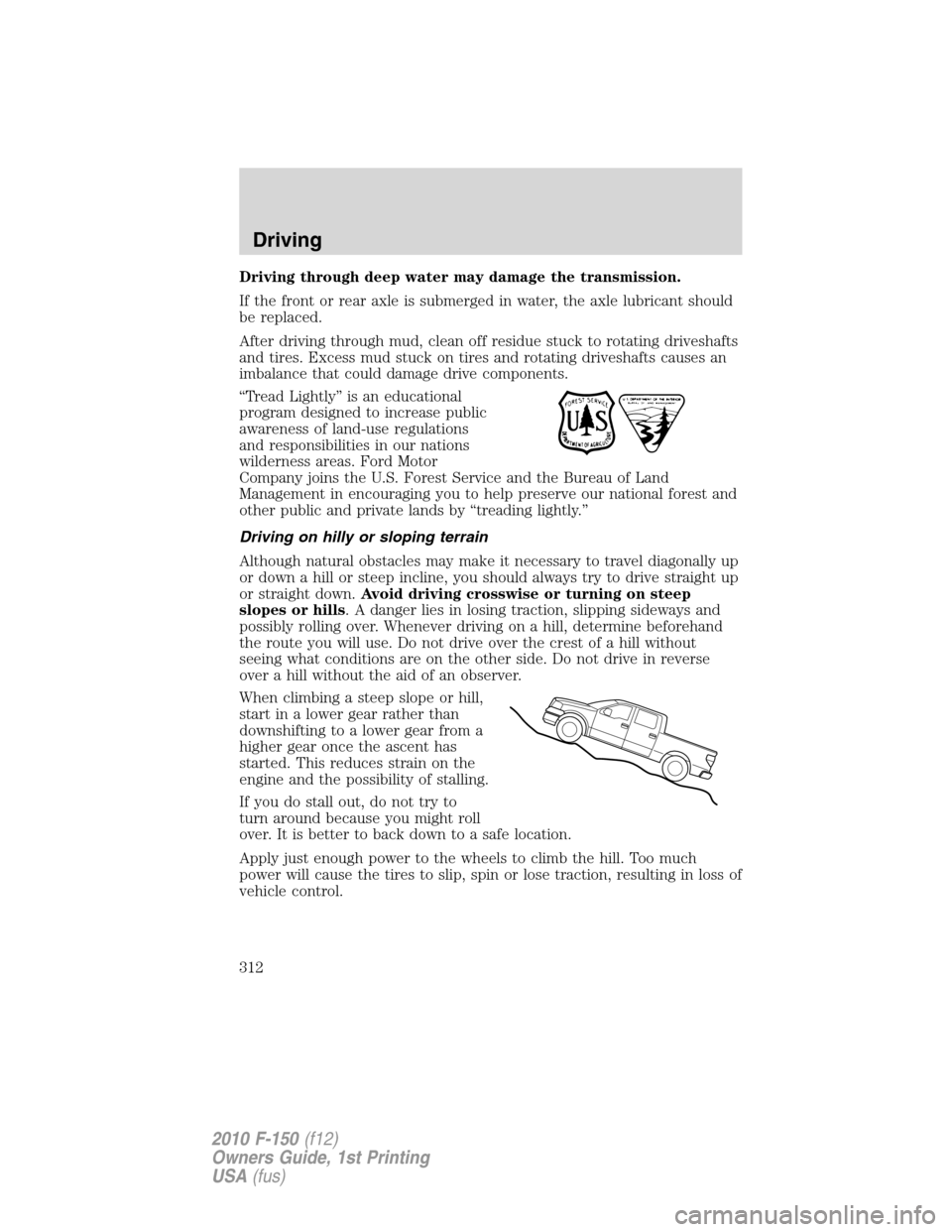
Driving through deep water may damage the transmission.
If the front or rear axle is submerged in water, the axle lubricant should
be replaced.
After driving through mud, clean off residue stuck to rotating driveshafts
and tires. Excess mud stuck on tires and rotating driveshafts causes an
imbalance that could damage drive components.
“Tread Lightly” is an educational
program designed to increase public
awareness of land-use regulations
and responsibilities in our nations
wilderness areas. Ford Motor
Company joins the U.S. Forest Service and the Bureau of Land
Management in encouraging you to help preserve our national forest and
other public and private lands by “treading lightly.”
Driving on hilly or sloping terrain
Although natural obstacles may make it necessary to travel diagonally up
or down a hill or steep incline, you should always try to drive straight up
or straight down.Avoid driving crosswise or turning on steep
slopes or hills. A danger lies in losing traction, slipping sideways and
possibly rolling over. Whenever driving on a hill, determine beforehand
the route you will use. Do not drive over the crest of a hill without
seeing what conditions are on the other side. Do not drive in reverse
over a hill without the aid of an observer.
When climbing a steep slope or hill,
start in a lower gear rather than
downshifting to a lower gear from a
higher gear once the ascent has
started. This reduces strain on the
engine and the possibility of stalling.
If you do stall out, do not try to
turn around because you might roll
over. It is better to back down to a safe location.
Apply just enough power to the wheels to climb the hill. Too much
power will cause the tires to slip, spin or lose traction, resulting in loss of
vehicle control.
Driving
312
2010 F-150(f12)
Owners Guide, 1st Printing
USA(fus)
Page 314 of 419
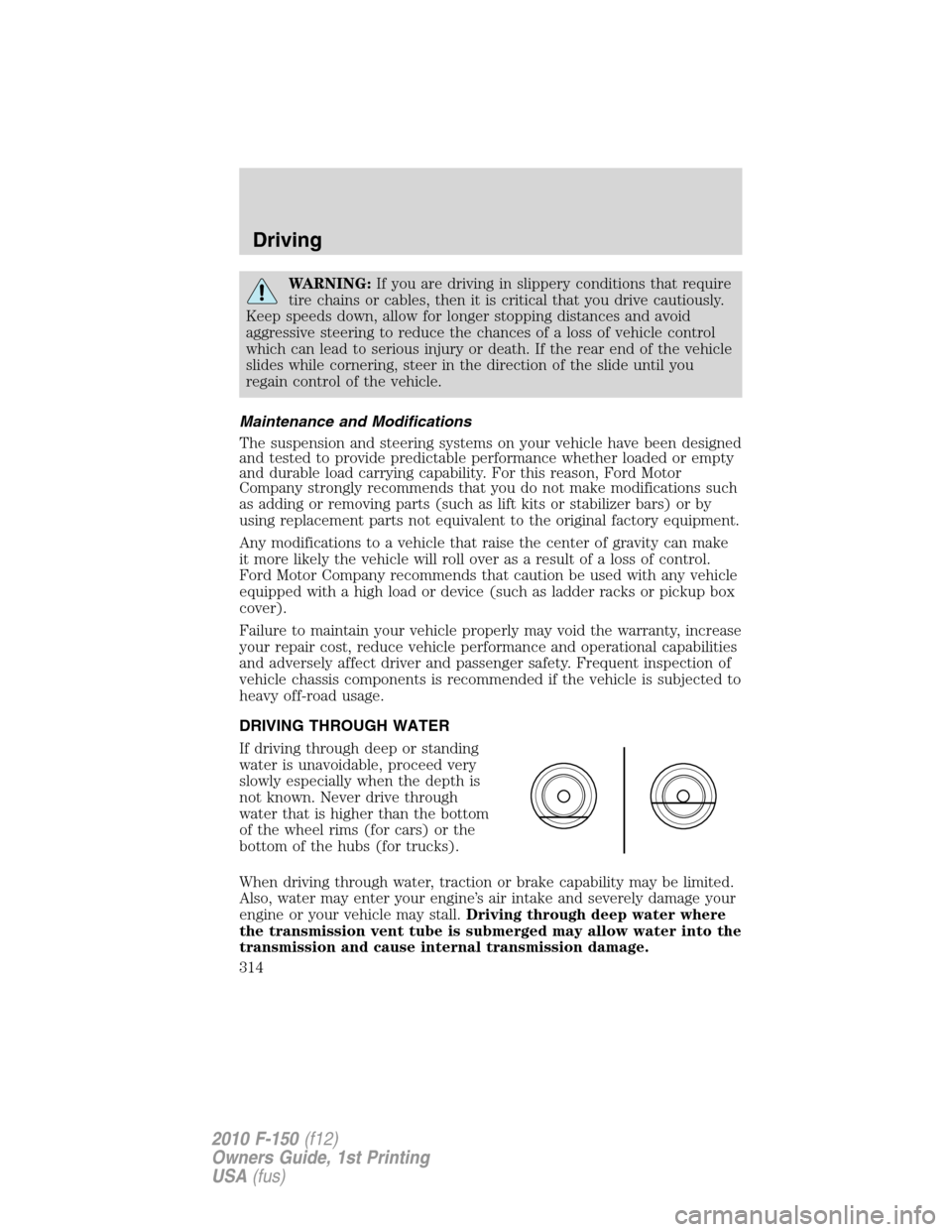
WARNING:If you are driving in slippery conditions that require
tire chains or cables, then it is critical that you drive cautiously.
Keep speeds down, allow for longer stopping distances and avoid
aggressive steering to reduce the chances of a loss of vehicle control
which can lead to serious injury or death. If the rear end of the vehicle
slides while cornering, steer in the direction of the slide until you
regain control of the vehicle.
Maintenance and Modifications
The suspension and steering systems on your vehicle have been designed
and tested to provide predictable performance whether loaded or empty
and durable load carrying capability. For this reason, Ford Motor
Company strongly recommends that you do not make modifications such
as adding or removing parts (such as lift kits or stabilizer bars) or by
using replacement parts not equivalent to the original factory equipment.
Any modifications to a vehicle that raise the center of gravity can make
it more likely the vehicle will roll over as a result of a loss of control.
Ford Motor Company recommends that caution be used with any vehicle
equipped with a high load or device (such as ladder racks or pickup box
cover).
Failure to maintain your vehicle properly may void the warranty, increase
your repair cost, reduce vehicle performance and operational capabilities
and adversely affect driver and passenger safety. Frequent inspection of
vehicle chassis components is recommended if the vehicle is subjected to
heavy off-road usage.
DRIVING THROUGH WATER
If driving through deep or standing
water is unavoidable, proceed very
slowly especially when the depth is
not known. Never drive through
water that is higher than the bottom
of the wheel rims (for cars) or the
bottom of the hubs (for trucks).
When driving through water, traction or brake capability may be limited.
Also, water may enter your engine’s air intake and severely damage your
engine or your vehicle may stall.Driving through deep water where
the transmission vent tube is submerged may allow water into the
transmission and cause internal transmission damage.
Driving
314
2010 F-150(f12)
Owners Guide, 1st Printing
USA(fus)
Page 317 of 419

WARNING:Do not attempt to service, repair, or modify the air
bag supplemental restraint system (SRS) or its fuses. See your
Ford or Lincoln Mercury dealer.
Transmission operation while plowing
•Shift transfer case to 4L (4WD Low) when plowing in small areas at
speeds below 5 mph (8 km/h).
•Shift transfer case to 4H (4WD High) when plowing larger areas or
light snow at higher speeds. Do not exceed 15 mph (24 km/h).
•Do not shift the transmission from a forward gear to R (Reverse) until
the engine is at idle and the wheels are stopped.
•If the vehicle is stuck, shift the transmission in a steady motion
between forward and reverse gears. Do not rock the vehicle for more
than a few minutes. The transmission and tires may be damaged or
the engine can overheat.
Do not rock the vehicle if the engine is not at operating
temperature. Do not rock the vehicle for more than a minute. The
transmission and tires may be damaged or the engine may
overheat.
WARNING:Do not spin the wheels at over 35 mph (55 km/h).
The tires may fail and injure a passenger or bystander.
Engine temperature while plowing
When driving with a plow, your engine may run at a higher temperature
than normal because the attached snowplow blade will restrict airflow to
the radiator.
If you are driving more than 15 miles (24 km) at temperatures above
freezing, angle the plow blade either full left or full right to provide
maximum airflow to the radiator.
If you are driving less than 15 miles (24 km) at speeds up to 40 mph
(64 km/h) in cold weather, you will not need to worry about blade
position to provide maximum airflow.
Driving
317
2010 F-150(f12)
Owners Guide, 1st Printing
USA(fus)
Page 327 of 419
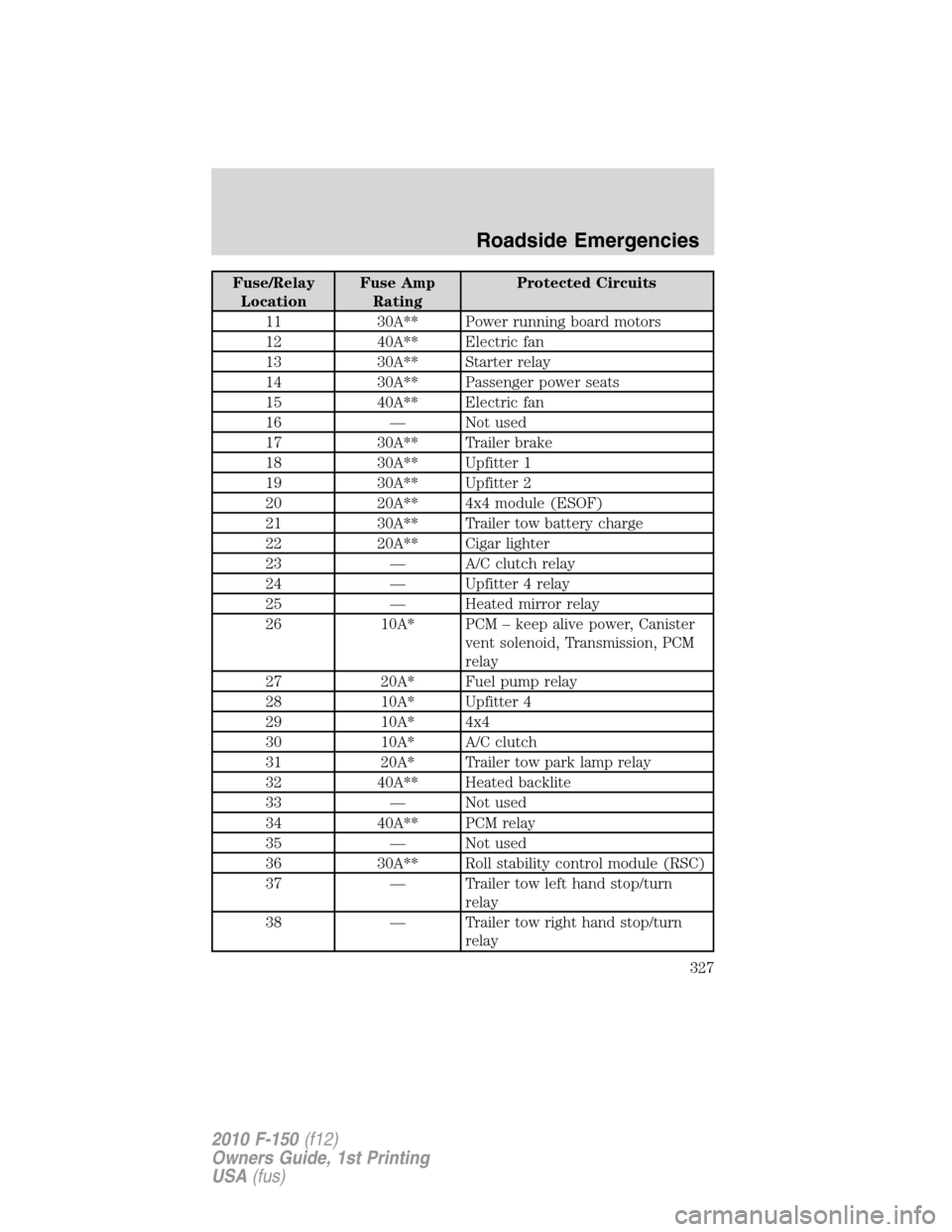
Fuse/Relay
LocationFuse Amp
RatingProtected Circuits
11 30A** Power running board motors
12 40A** Electric fan
13 30A** Starter relay
14 30A** Passenger power seats
15 40A** Electric fan
16 — Not used
17 30A** Trailer brake
18 30A** Upfitter 1
19 30A** Upfitter 2
20 20A** 4x4 module (ESOF)
21 30A** Trailer tow battery charge
22 20A** Cigar lighter
23 — A/C clutch relay
24 — Upfitter 4 relay
25 — Heated mirror relay
26 10A* PCM – keep alive power, Canister
vent solenoid, Transmission, PCM
relay
27 20A* Fuel pump relay
28 10A* Upfitter 4
29 10A* 4x4
30 10A* A/C clutch
31 20A* Trailer tow park lamp relay
32 40A** Heated backlite
33 — Not used
34 40A** PCM relay
35 — Not used
36 30A** Roll stability control module (RSC)
37 — Trailer tow left hand stop/turn
relay
38 — Trailer tow right hand stop/turn
relay
Roadside Emergencies
327
2010 F-150(f12)
Owners Guide, 1st Printing
USA(fus)
Page 328 of 419
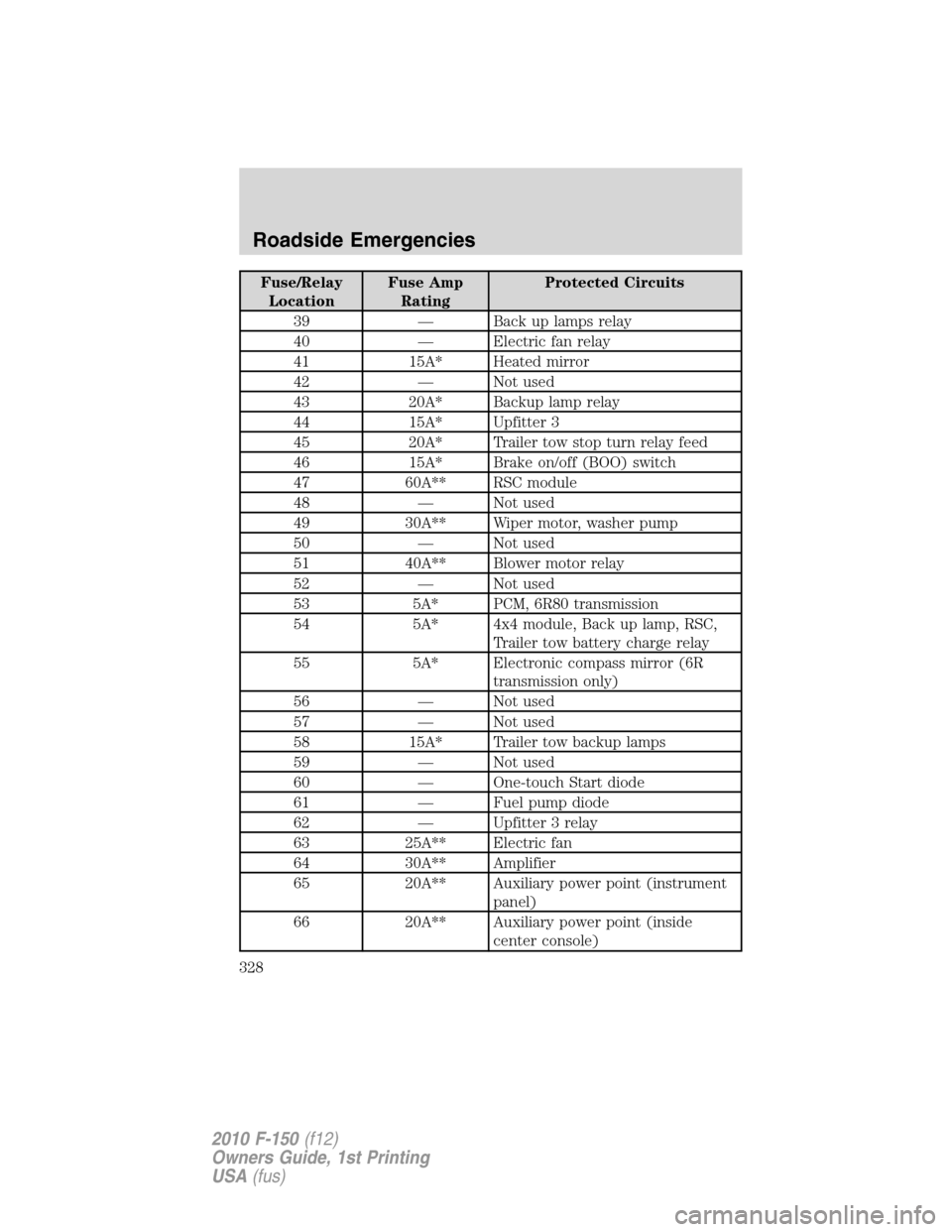
Fuse/Relay
LocationFuse Amp
RatingProtected Circuits
39 — Back up lamps relay
40 — Electric fan relay
41 15A* Heated mirror
42 — Not used
43 20A* Backup lamp relay
44 15A* Upfitter 3
45 20A* Trailer tow stop turn relay feed
46 15A* Brake on/off (BOO) switch
47 60A** RSC module
48 — Not used
49 30A** Wiper motor, washer pump
50 — Not used
51 40A** Blower motor relay
52 — Not used
53 5A* PCM, 6R80 transmission
54 5A* 4x4 module, Back up lamp, RSC,
Trailer tow battery charge relay
55 5A* Electronic compass mirror (6R
transmission only)
56 — Not used
57 — Not used
58 15A* Trailer tow backup lamps
59 — Not used
60 — One-touch Start diode
61 — Fuel pump diode
62 — Upfitter 3 relay
63 25A** Electric fan
64 30A** Amplifier
65 20A** Auxiliary power point (instrument
panel)
66 20A** Auxiliary power point (inside
center console)
Roadside Emergencies
328
2010 F-150(f12)
Owners Guide, 1st Printing
USA(fus)
Page 329 of 419
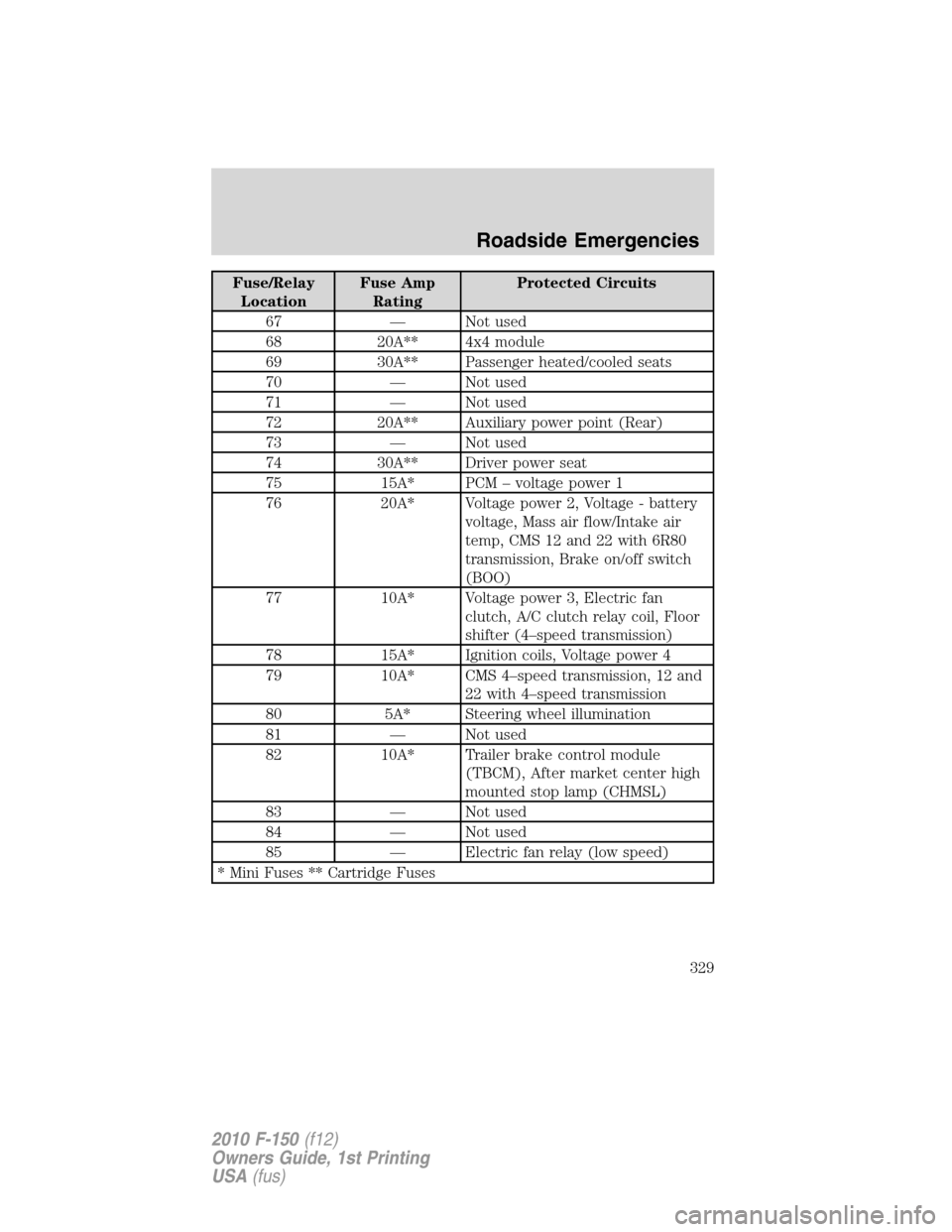
Fuse/Relay
LocationFuse Amp
RatingProtected Circuits
67 — Not used
68 20A** 4x4 module
69 30A** Passenger heated/cooled seats
70 — Not used
71 — Not used
72 20A** Auxiliary power point (Rear)
73 — Not used
74 30A** Driver power seat
75 15A* PCM – voltage power 1
76 20A* Voltage power 2, Voltage - battery
voltage, Mass air flow/Intake air
temp, CMS 12 and 22 with 6R80
transmission, Brake on/off switch
(BOO)
77 10A* Voltage power 3, Electric fan
clutch, A/C clutch relay coil, Floor
shifter (4–speed transmission)
78 15A* Ignition coils, Voltage power 4
79 10A* CMS 4–speed transmission, 12 and
22 with 4–speed transmission
80 5A* Steering wheel illumination
81 — Not used
82 10A* Trailer brake control module
(TBCM), After market center high
mounted stop lamp (CHMSL)
83 — Not used
84 — Not used
85 — Electric fan relay (low speed)
* Mini Fuses ** Cartridge Fuses
Roadside Emergencies
329
2010 F-150(f12)
Owners Guide, 1st Printing
USA(fus)
Page 334 of 419
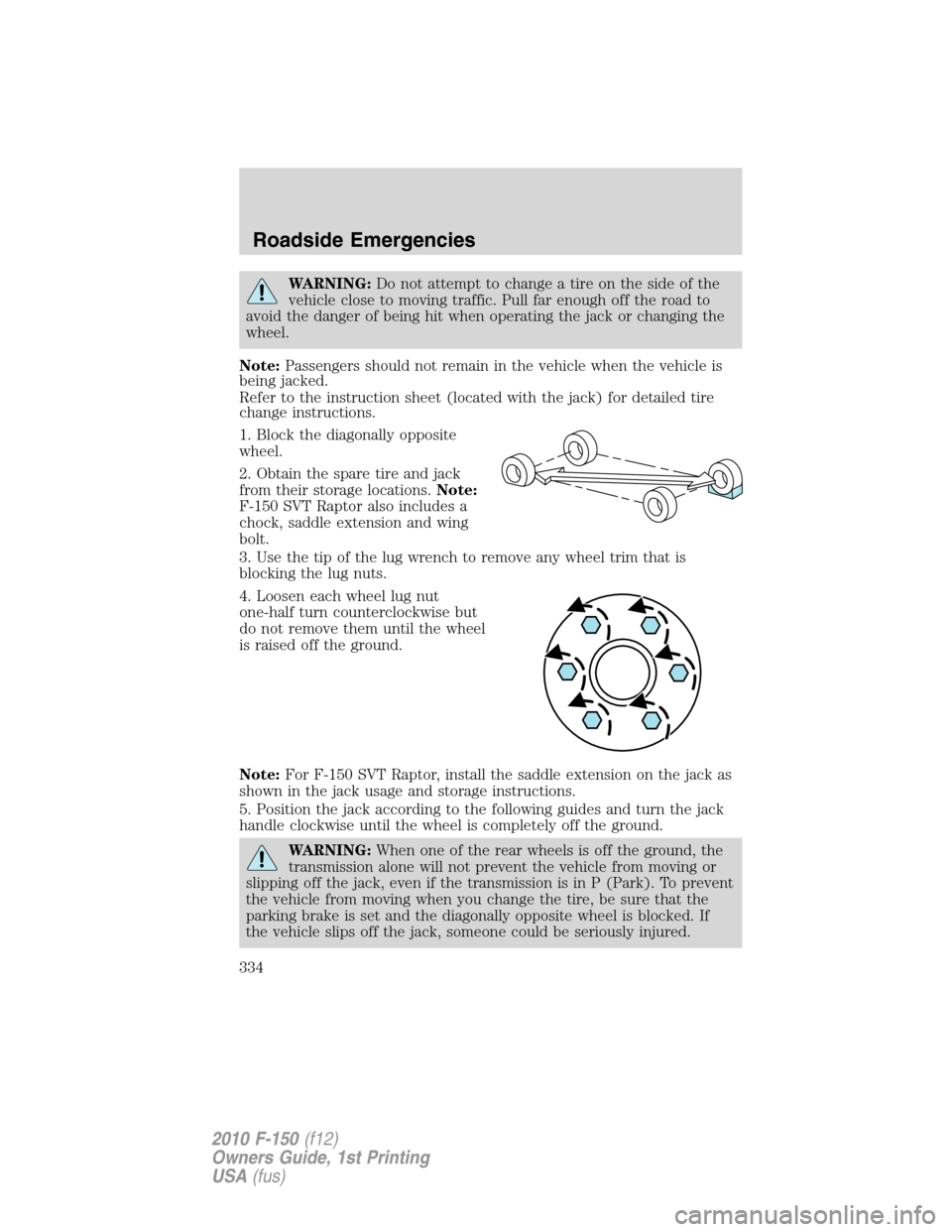
WARNING:Do not attempt to change a tire on the side of the
vehicle close to moving traffic. Pull far enough off the road to
avoid the danger of being hit when operating the jack or changing the
wheel.
Note:Passengers should not remain in the vehicle when the vehicle is
being jacked.
Refer to the instruction sheet (located with the jack) for detailed tire
change instructions.
1. Block the diagonally opposite
wheel.
2. Obtain the spare tire and jack
from their storage locations.Note:
F-150 SVT Raptor also includes a
chock, saddle extension and wing
bolt.
3. Use the tip of the lug wrench to remove any wheel trim that is
blocking the lug nuts.
4. Loosen each wheel lug nut
one-half turn counterclockwise but
do not remove them until the wheel
is raised off the ground.
Note:For F-150 SVT Raptor, install the saddle extension on the jack as
shown in the jack usage and storage instructions.
5. Position the jack according to the following guides and turn the jack
handle clockwise until the wheel is completely off the ground.
WARNING:When one of the rear wheels is off the ground, the
transmission alone will not prevent the vehicle from moving or
slipping off the jack, even if the transmission is in P (Park). To prevent
the vehicle from moving when you change the tire, be sure that the
parking brake is set and the diagonally opposite wheel is blocked. If
the vehicle slips off the jack, someone could be seriously injured.
Roadside Emergencies
334
2010 F-150(f12)
Owners Guide, 1st Printing
USA(fus)
Page 338 of 419

Note:Inspect the wheel pilot hole
prior to installation. If there is
visible corrosion in wheel pilot hole,
remove loose particles by wiping
with clean rag and apply grease.
Apply grease only to the wheel pilot
hole surface by smearing a “dime”
(1 square cm) sized glob of grease
around the wheel pilot surface (1)
with end of finger. DO NOT apply
grease to lugnut/stud holes or
wheel-to-brake surfaces.
RUNNING OUT OF FUEL
If you have run out of fuel and need to refill the vehicle with a portable
fuel container, seeRunning out of fuelin theMaintenance and
Specificationschapter for proper fuel filling method using a portable
fuel container and the included fuel filler funnel.Do notinsert the
nozzle of portable fuel containers or any type of aftermarket funnels into
the Easy Fuel™ “no cap” fuel system as it can be damaged. You must
use the included funnel in such circumstances.
WARNING:Do not insert the nozzle of portable fuel containers
or aftermarket funnels into the Easy Fuel™ system. This could
damage the fuel system and its seal, and may cause fuel to run onto
the ground instead of filling the tank, all of which could result in
serious personal injury.
JUMP STARTING
WARNING:The gases around the battery can explode if
exposed to flames, sparks, or lit cigarettes. An explosion could
result in injury or vehicle damage.
WARNING:Batteries contain sulfuric acid which can burn skin,
eyes and clothing, if contacted.
Do not attempt to push-start your automatic transmission
vehicle. Automatic transmissions do not have push-start
capability. Attempting to push-start a vehicle with an automatic
transmission may cause transmission damage.
Roadside Emergencies
338
2010 F-150(f12)
Owners Guide, 1st Printing
USA(fus)